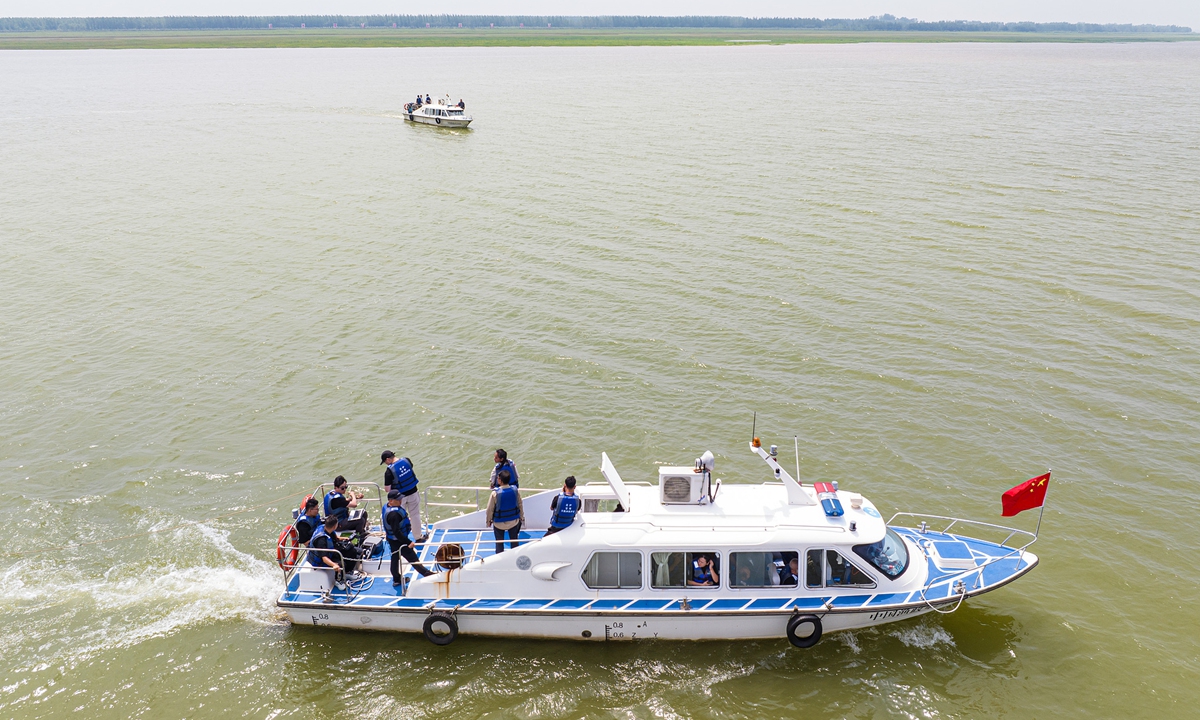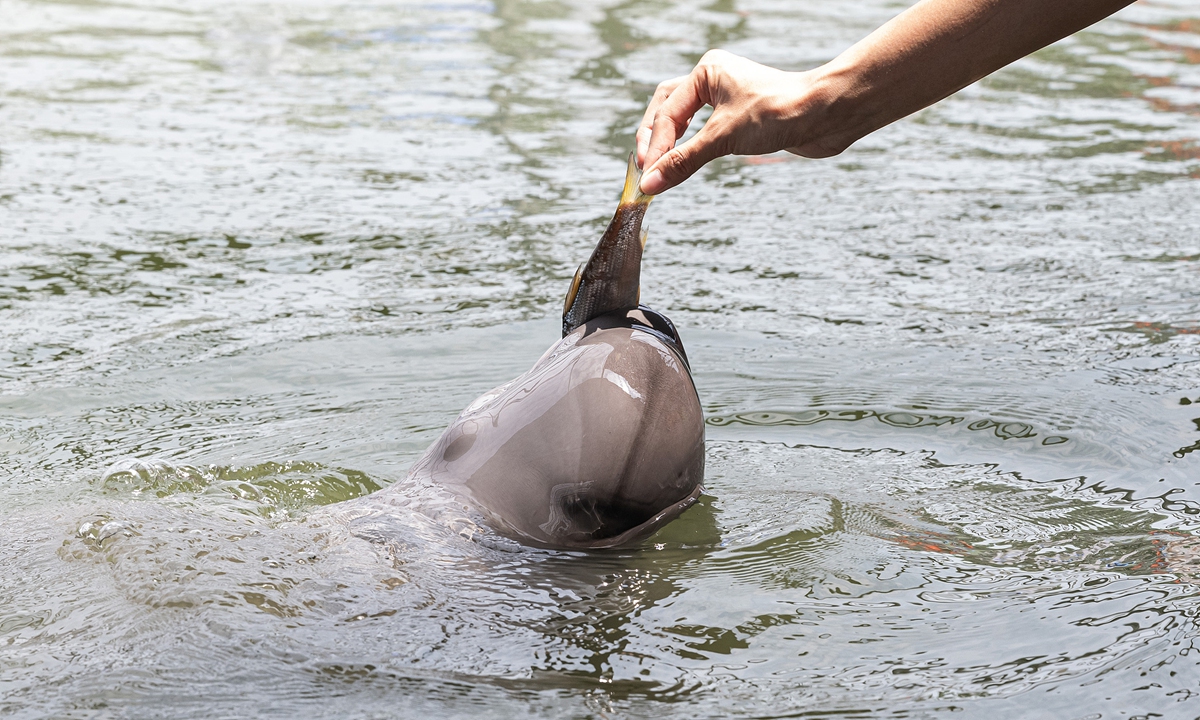
Newsroom
China's Porpoise Protection Model Inspires Southeast Asia

Two patrol boats cruise on the waterways in Jingzhou, Central China's Hubei Province. Photo: VCG
"Fang Fang, Fang Fang," Im Rachna, undersecretary of state with Cambodia's Ministry of Agriculture, Forestry and Fisheries, chants the name of a Yangtze finless porpoise, feeding it small fish during her trip to a nature reserve in Central China's Hubei Province on June 5.
Rachna is one of the 19 experts and officials from five Southeast Asian countries, including Cambodia, Indonesia, Laos, Myanmar and Thailand, who visited Hubei, Hunan and East China's Jiangsu Province to discuss strategies to protect endangered freshwater dolphins and establish an international cooperation framework for cetaceans conservation with their Chinese counterparts during their ongoing trip to China.
During the week-long workshop, Chinese experts shared insights on habitat protection, ex-situ conservation strategies and artificial breeding programs, with a focus on applying China's successful Yangtze finless porpoise conservation model in safeguarding critically endangered Irrawaddy dolphins living in Southeast Asia.
Another participant of the workshop Phay Somany, a deputy director of the Fisheries Conservation Department at the Fisheries Administration of Cambodia's MAFF, told the Global Times on Wednesday that he was impressed with China's efforts in protecting the Yangtze finless porpoises.
"I'm impressed that the population of the Yangtze porpoise has increased to 1,249 in China in recent years. We learned the techniques to rescue injured dolphins, captive breeding program, raising public awareness about the importance of conservation and management of the Yangtze finless porpoises and aquatic biodiversity during our visit to Wuhan and Jiangsu," Somany said.
In recent years, the population of Irrawaddy dolphins in the Mekong River has increased by about 20 individuals. However, rescue and conservation efforts remain extremely challenging, said Rachna, who looked forward to deeper cooperation with their Chinese counterparts.
'One Plan Approach'
Once facing a continuous population decline, the Yangtze finless porpoise is an endemic freshwater cetacean species of the mother river.
In response, China has explored a three-pronged conservation strategy: In-situ protection, ex-situ conservation and captive breeding. These efforts have led to the development of a comprehensive conservation system.
According to a 2022 scientific survey, the Yangtze finless porpoise population had reached 1,249 individuals, marking the first time that the population had stopped declining and begun to recover, according to a report by the Institute of Hydrobiology, Chinese Academy of Sciences.
In contrast, the Irrawaddy dolphin, another endangered freshwater species, demands urgent action.
Its global freshwater populations are fragmented into three isolated sub-populations in Cambodia's Mekong River, Myanmar's Irrawaddy River and the Mahakam River in Indonesia, each consisting of fewer than 100 individuals, the Xinhua News Agency reported.
Wang Kexiong, secretary general of Wuhan Baiji Conservation Foundation (WBCF), shared China's experience in protecting the Yangtze porpoise with international experts during the trip.
Wang told the Global Times that China's approach to protecting the Yangtze porpoise stands out for its holistic model, combining policy, science, education and public participation into what's known as an "One Plan Approach."
When it comes to protecting large species in the Yangtze River, no single measure is sufficient to address the issue.
Under the joint efforts of the Wuhan foundation and the Institute of Hydrobiology, the local government of Wuhan introduced a work plan for promoting the return of the Yangtze finless porpoise to the urban section of the Yangtze River in Wuhan, which is a typical example of policy-driven conservation, Wang noted.
The Institute of Hydrobiology has spent nearly 50 years developing key technologies such as ex-situ conservation for the porpoise and porpoise breeding techniques, representing science-driven conservation.
Meanwhile, the WBCF has established 10 porpoise protection model schools along the middle and lower reaches of the Yangtze River, an example of how education and public engagement contribute to porpoise protection, said the secretary general.
In the field of real-time acoustic monitoring of finless porpoises, China currently holds a leading position internationally.
The technology enables real-time tracking of porpoise activities and population data across multiple water bodies. It is also capable of effectively monitoring porpoises in areas with frequent human activities and issuing timely conservation alerts, he added.
Given that Irrawaddy dolphins are primarily threatened by accidental bycatch in fisheries, this monitoring technology can be applied in key habitats to issue real-time alerts to local fishers, according to Wang.

A person feeds a Yangtze finless porpoise in Jingzhou, Central China's Hubei Province. Photo: VCG
Switched roles
In addition to the real-time monitoring, Somany said that China's fishing ban and providing alternative livelihood options to local fishermen are some of the strategies that could be adapted for the conservation and management of the Irrawaddy dolphins.
To restore the biodiversity along the river, China imposed a full fishing ban in 332 conservation areas along the Yangtze River basin in January 2020. The move has since been expanded to a 10-year moratorium along the river's main streams and major tributaries, effective in January 2021, Xinhua reported.
"This fishing ban has impressed me a lot as the government encouraged fishermen to take part in the law enforcement and assigned them to be river guards, providing housing and different livelihood options to local fishermen," Somany said.
Wang Shicheng, a member of the Nanjing Finless Porpoise Aquatic Life Protection Association, told the Global Times on Tuesday that protecting the Yangtze porpoise wouldn't be possible without the involvement and support of local residents.
After the fishing ban, the local fishermen switched their roles to patrollers, guardians and porpoise observers along the river, documenting the regular presence and behaviors of the porpoises, said the expert.
China's successful model of porpoise conservation, such as ex-situ protection, has offered more possibilities for overseas species. Establishing international cooperation frameworks could help foster a coordinated effort in the conservation of cetacean species, according to the expert.
Wang Kexiong expressed hope that China's "One Plan Approach" for the Yangtze finless porpoise can be applied to the research and conservation of small riverine cetaceans in Southeast Asia and South America, yielding tangible conservation outcomes and allowing the story of porpoise protection to be shared and implemented in other countries.